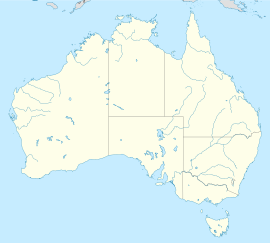 Brisbane /ˈbrɪzbən/[2] is the capital and most populous city in the Australian state of Queensland,[3] and the third most populous city in Australia. Brisbane's metropolitan area has a population of 2.3 million,[4] and the South East Queensland urban conurbation, centred on Brisbane, encompasses a population of more than 3.4 million.[4] The Brisbane central business district stands on the original European settlement and is situated inside a bend of the Brisbane River, about 15 kilometres (9 miles) from its mouth at Moreton Bay.[5] The metropolitan area extends in all directions along the floodplain of the Brisbane River valley between Moreton Bay and the Great Dividing Range. The metropolitan area sprawls across several of Australia's most populous local government areas (LGA), including the City of Brisbane, which is by far the most populous LGA in the nation. The demonym of Brisbane is Brisbanite.
Brisbane /ˈbrɪzbən/[2] is the capital and most populous city in the Australian state of Queensland,[3] and the third most populous city in Australia. Brisbane's metropolitan area has a population of 2.3 million,[4] and the South East Queensland urban conurbation, centred on Brisbane, encompasses a population of more than 3.4 million.[4] The Brisbane central business district stands on the original European settlement and is situated inside a bend of the Brisbane River, about 15 kilometres (9 miles) from its mouth at Moreton Bay.[5] The metropolitan area extends in all directions along the floodplain of the Brisbane River valley between Moreton Bay and the Great Dividing Range. The metropolitan area sprawls across several of Australia's most populous local government areas (LGA), including the City of Brisbane, which is by far the most populous LGA in the nation. The demonym of Brisbane is Brisbanite.
maps are also distinct for the global knowledge required to construct them. A meaningful map of the world could not be constructed before the European Renaissance because less than half of the earth's coastlines, let alone its interior regions, were known to any culture. New knowledge of the earth's surface has been accumulating ever since and continues to this day. Maps of the world generally focus either on political features or on physical features. Political maps emphasize territorial boundaries and human settlement. Physical maps show geographic features such as mountains, soil type or land use. Geological maps show not only the surface, but characteristics of the underlying rock, fault lines, and subsurface structures. Choropleth maps use color hue and intensity to contrast differences between regions, such as demographic or economic statistics.
Tuesday, August 4, 2015
Brisbane Map
2:51 PM
Maps
 Brisbane /ˈbrɪzbən/[2] is the capital and most populous city in the Australian state of Queensland,[3] and the third most populous city in Australia. Brisbane's metropolitan area has a population of 2.3 million,[4] and the South East Queensland urban conurbation, centred on Brisbane, encompasses a population of more than 3.4 million.[4] The Brisbane central business district stands on the original European settlement and is situated inside a bend of the Brisbane River, about 15 kilometres (9 miles) from its mouth at Moreton Bay.[5] The metropolitan area extends in all directions along the floodplain of the Brisbane River valley between Moreton Bay and the Great Dividing Range. The metropolitan area sprawls across several of Australia's most populous local government areas (LGA), including the City of Brisbane, which is by far the most populous LGA in the nation. The demonym of Brisbane is Brisbanite.
Brisbane /ˈbrɪzbən/[2] is the capital and most populous city in the Australian state of Queensland,[3] and the third most populous city in Australia. Brisbane's metropolitan area has a population of 2.3 million,[4] and the South East Queensland urban conurbation, centred on Brisbane, encompasses a population of more than 3.4 million.[4] The Brisbane central business district stands on the original European settlement and is situated inside a bend of the Brisbane River, about 15 kilometres (9 miles) from its mouth at Moreton Bay.[5] The metropolitan area extends in all directions along the floodplain of the Brisbane River valley between Moreton Bay and the Great Dividing Range. The metropolitan area sprawls across several of Australia's most populous local government areas (LGA), including the City of Brisbane, which is by far the most populous LGA in the nation. The demonym of Brisbane is Brisbanite.




